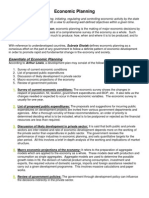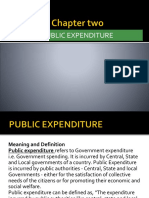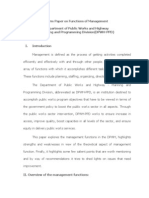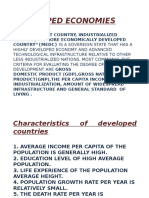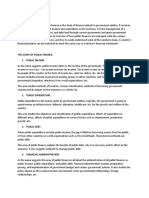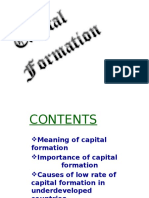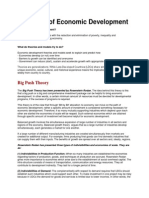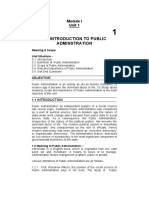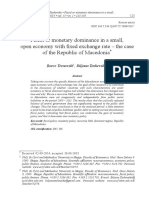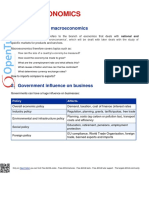Professional Documents
Culture Documents
Development Planning - Lesson Notes
Development Planning - Lesson Notes
Uploaded by
Mapalo kasondeOriginal Description:
Original Title
Copyright
Available Formats
Share this document
Did you find this document useful?
Is this content inappropriate?
Report this DocumentCopyright:
Available Formats
Development Planning - Lesson Notes
Development Planning - Lesson Notes
Uploaded by
Mapalo kasondeCopyright:
Available Formats
DEVELOPMENT PLANNING LESSON NOTES (TERM 1 2022)
TOPIC STUDY GUIDE
1. Define the concept “Planning”
2. Describe the meaning of “development”
3. Describe “Development Planning”
4. Differentiate “Development Planning” from “Development Plan”
5. Explain the importance of planning
6. Discuss the purpose of planning
7. Identify the levels of planning
8. List and explain the types of planning
9. Discuss the methods of planning
10. Define the term ‘budget’ and identify its types
11. Describe National Budgeting process in Zambia
12. Discuss Fiscal Discipline in relation to budget implementation
13. Identify and analyse Zambia’s National Development Plans since independence
14. Explain the national long-term Vision 2030
15. Differentiate Micro from Macro Financial Institutions
16. Identify micro and Macro financial institutions that provide financial aid
17. Explain the functions of Micro and Macro financial institutions
18. Explain what is meant by “Indicators of Development”
19. Identify methods used to measure development.
1. Definition of the concept “Planning”
-Planning, also called “Forethought” is a process of organizing activities and
laying out steps required to achieve a desired goal.
-Planning therefore, involves the creation and maintenance of a plan.
-The plan must reflect systematically arranged steps, identified specific resources
and the time frame in which the specific goal will be achieved.
2. Development.
-It is the process of improvement from the old to something completely new.
-It can also mean the replacement of the old by the new.
3. Development Plan
- It is a component of country planning comprising a set of documents that outlines
government policies and proposals on how resources must be used in order to develop
the country.
Compiled by Kabanshi Kalebaila J
4. National Development Planning
-It i is a deliberate effort by the state aimed at achieving certain set goals such as
raising the standard of living of people
-NOTE that Development Planning is about identifying the needs, collection and
allocation of resources, setting out objectives and strategies (steps) to achieve
developmental goals within the specified period of time.
5. Importance of Development Planning
-It predicts what the future should look like.
-It reduces the necessary time and effort of achieving a goal
-It provides against wastage of resources
-It provides a perfect mirror to tell if a country is making progress or not
-It provides an opportunity to implement development activities in a more organized
manner.
6. Purpose of Planning
The purpose of planning is to provide for;
- a statement of general objectives of economy and social policy
- an evaluation of progress achieved under the preceding plan.
- an assessment of current economic conditions especially national income, productive
and foreign trade
- the current social situation especially population changes, education, health housing
and social security
- estimates of the growth, or social component during the period covered by the plan.
- Measures designed to raise the rate of economic growth for example:- to stimulate
saving and investment and to increase productivity which are impossible to achieve.
- movement towards a sustainable growth
7. Levels of Planning
-Planning takes place at the following levels;
(a) Individual Level-----e.g. a farmer needs resources such as seed, fertilizer,
hoes/ploughs, money for labour, transportation of materials and so on. Therefore, a
detailed plan and a budget plan is required.
Compiled by Kabanshi Kalebaila J
(b) Community Level ---- The community needs to plan for community projects such as
construction of a school, clinic in terms of materials needed, cost of labour and the
source of funds for the projects.
(c) National Level ------Government needs a plan and budget for projects such as
construction of a bridge, roads, hospitals and schools.
(d) International Level -----e.g the United Nations Organisation has set out
international development targets known as the Sustainable Development Goals from
2015 onwards..
8. Types of Development Planning
Most plans fall under three categories. These include the following;
(a). Short Term Plan:
-It is a plan which may cover a short period from six months to one year.
(b) Medium Term Plan
-This is a plan that ranges from three to seven years, with five years as the most
popular choice.
(c) Long Term Plan
- It is sometimes referred to as the Long Range Development Plan (LRDP). It covers a
period of ten to twenty years and above.
Note: Long term plan is mostly needed for the implementation of capital projects such
as:
-Construction of Hydro-electric power Stations.
-Opening new Mines.
-Reforestation.
-Construction of new roads and railway lines.
9. Methods of Planning
-There are two methods of planning. These are
(a) Centralised Planning:
-This is the type of planning done by the central government without involvement of the
local communities.
Compiled by Kabanshi Kalebaila J
Problems associated with Centralised Planning
This kind of planning has brought the following problems in developing countries like
Zambia.
- Planning is normally dominated by expatriate advisors who know very little about local
communities
- Local conditions are not regarded.
- It lacks participation of the local community in its formulation and implementation
leading to lack of ownership of the outcome.
- Delays in approving the plan as it is referred to the headquarters before
implementation.
- It denies the local people the sense of belonging as they are by passed since the plan
is imposed in top-down fashion on local communities
(b) Decentralised Planning:
-It is sometimes called “Participatory Planning”
- This is planning done at the grassroots by involving the local communities.
Note: Since the year 2000, Decentralised Planning has been re-introduced in Zambia
through activity based budgeting plans in the community.
Advantages of Decentralised Planning
-there is speedy approval of plans since decision-making is done at local level
-it more democratic in nature as it allows local people to participate in planning process
-Plans initiated at community level are widely accepted and owned by the local people
-It is inclusive in nature
-It takes into account the local conditions of given communities
10. The Budget
-At national level, a budget is a forecast which reflects the balance between government
expenditure and revenue (income) for a specific period of time.
-At individual or family level a budget is simply an estimate of expenditure and income.
Types of Budget
-There are generally three types of budget. These include;
Compiled by Kabanshi Kalebaila J
(a) Individual / Personal Budget---- It is a finance plan that allocates future personal
income towards expenses, savings and debt repayment.
(b) Family Budget ---Like a personal budget, a family budget is a financial plan for
income and expenses. It is normally done monthly taking into account all sources of
family income and expenses.
(c) National Budget ---- This is a document which estimates the anticipated government
revenues and government expenditure for the financial year. The national budget is
sometimes called the Annual Financial Statement of the country.
-The national budget is prepared by the Ministry of Finance and National Planning. It is
presented to parliament every year by the Minister of Finance.
11. The Budget Process in Zambia
-Given below are the stages through which the national budget goes through:
Stage 1: Drafting of a Green Paper which involves compiling all requirements from
various ministries and other departments. (Note: Green paper in just the name of a
document and not that the paper is green!)
Stage 2: Consolidation of Green Paper--A consolidated Green Paper is sent to
cabinet for approval. After approval the Green Paper is then printed for circulation to
members of the public.
Stage 3: All Ministries receive Ceilings (Maximum amount each Ministry mush
budget for)----Cabinet send ceilings to all ministries, provincial and spending agencies
together with the timetable for discussions.
Stage 4: Completion of budget draft for cabinet approval ---- Cabinet discusses and
considers proposals or revenue measures included in the draft budget. Once approved,
the budget is now referred to as Estimates of Revenue and Expenditure also known as
the “Yellow Book”. The Budget Speech to be presented to Parliament is also prepared.
Stage 5: Presentation of Budget to National Assembly ---- The consolidated
proposed National Budget in now presented to the National Assembly as a Bill for
approval. The Minister of Finance presents the budget to National Assembly.
Budget Execution
-Budget execution simply means implementation of the budget. The Minister of Finance
informs Ministries, provinces and other Spending agencies whenever funds are
released for programme implementation.
-After the National Budget has been presented to National Assembly, two Bills are
prepared meant to formalize what is contained in the budget. These two Bills are:
Compiled by Kabanshi Kalebaila J
(a) The Supplementary Appropriation Bill
(b)The Excess Expenditure Appropriation Bill
The General Warrant (GW)
-It is a document that gives authority to the Secretary to the Treasury to release funds
for the implementation of programmes. The GW is only valid if it is signed by the
President.
12. Importance of budgeting and fiscal discipline in development planning
Fiscal discipline
-It means strict control of public resources.
-Therefore, budgeting and Fiscal discipline ensures strict control of public resources and
compliance in taxation and public expenditure
Importance of a Budget
-A budget is very important because;
(a) It is a control measure which helps government to control spend money wisely
(b) It helps government to equitably (fairly) spend money and allocate resources to all
needy areas
(c) It promotes accountability. This means that the government or any other citizen will
tell if money has been spent wisely or not.
Some measures put in place to enhance fiscal discipline.
-Government to cut its expenditure and directs its resources only on essential areas
such as education, health and agriculture.
-Punish Public officials who misuse or misappropriate government or public funds.
-Take measures to ensure compliance in taxation (Payment of tax)
-As much as possible avoid external borrowing unless that borrowing is towards
economic growth through productive investment such a agriculture and manufacturing.
Compiled by Kabanshi Kalebaila J
13 ZAMBIA’S DEVELOPMENT PLANS
Since independence in 1964, Zambia has produced and implemented a number of
National Development Plans. Given below are the plans.
1. Emergency Development Plan (EDP)
-The plan was launched immediately after independence as the first step to restructure
the inherited colonial Capitalist economy.
-The colonial government had a national development plan known as the Capital
Development Plan (CDP) which covered the period from 1961 – 1965.
-but since Zambia had got her independence in 1964, an emergency development plan
was needed to align developmental programmes with the policies of the new
independent self government.
-The EDP therefore, provided a frame work for more comprehensive programs of
economic and social development
2. National Transition Development plan (NTDP)1965- 1966
Main focus of the NTDP
- to spend money on extension of transport, power and communications services
- It also focused on the improvement of agriculture and education. Primary and
secondary schools were built in each district.
3. First Development Plan (FNDP) 1966- 1971
Aims
-To diversify the economy from copper mining to agriculture and manufacturing
-To develop the rural areas
-To expand welfare services such as housing and building more hospitals
-To improve power and transport and communication services
-To create 100,000 new by the end of 1970
Compiled by Kabanshi Kalebaila J
4. Second Development Plan (SNDP) 1972- 1976
Goals of the SNDP
- to increase and expand the diversification process initiated under FNDP.
- attaining self-sufficiency in food supplies and improvement in income
- expanding and diversifying industry and mining through import substitution by using
Local materials
- initiating measures for regional development
- linking educational programs to the countries manpower requirements
- improve the existing infrastructure such as power, transport and communication
5.Third National Development Plan (TNDP) 1980 – 1983
It had the following provisions:-
-Allocating investment funds and creating a base for the transformation of society
through socialism and Humanism
-Involving the private sector in economic and social development while taking into
account Socialist and Humanist ideas.
-Balanced development with regard to linkages between industry and agriculture
-Increasing the production of consumer and capital goods
-Fair income distribution and creating and egalitarian (Communal Society)
-Diversification of the economy and rural development
-Expanding education training facilities to speed up Zambianasation
NOTE: Zambinisation was a local term which meant a deliberate programme to train
Zambians in order for them to take up positions held by foreigners in various economic
and social sectors,
6 .Fourth Development Plan (FNDP) 1989- 1993
-Before this FNDP was developed, there was a plan called the New Economic
Recovery Programmee which covered the period from July 1987 to December 1988.
This plan was developed because of the worsening economic crisis caused by high
prices of oil.
The FNDP focused on:-
-Periodic review of the exchange rate and interest rates
Compiled by Kabanshi Kalebaila J
-The reduction of budget deficit to below 2% of Gross Domestic Product (GDP) by 1993
-A gradual reduction of subsidies so as to reduce pressure on the budget.
-Reduction in the annual growth of money supply to below 40% by 1993
-Reduction in the rate of inflation to below 20% in 1993
-Increase capacity utilization to above 70% of industrial averages by 1993
-Reducing the number of price controlled items to one by 1993
NOTE: The MMD Government under President Fredrick Chiluba abandoned National
Development plans. Therefore, between 1991 and 2001 there was no National
Development Plan, instead the government introduced Annual Cash Budgets.
7. Transitional National Development Plan (TNDP)-2002-2005
In 2002, the government, under President Levy Patrick Mwanawasa, re-introduced
National Development Plan which was expected to run from 2002 to 2005 and
thereafter, the fifth National development plan.
The major programme under the TNDP was poverty reduction strategy programme
PRSP the main focus of which was reducing poverty and the debt burden.
8. Fifth National Development Plan(FNDP) 2006-2010
The fifth National development was based on the Vision 2030 and covered the period
2006 – 2010. Some of the goals include:-
-Develop and rehabilitate infrastructure
-Develop and build human resource and capacity respectively
-Mainstream cross cutting issues such as HIVAIDS, gender, democracy, good
governance, human rights and environment
-Develop irrigation in both private and public sectors
9. Sixth National Development (SNDP) 2011-2015
-It covers a period from 2011- 2015
-Its main objectives were
- to speed up Infrastructure rehabilitation and development
Compiled by Kabanshi Kalebaila J
- to address cross-cutting issues e.g. HIV/AIDS.
- to embark on rural electrification.
To -promote economic investment and diversification
- Promote rural and urban water and sanitation
-embark on rural investment and poverty reduction
NOTE: The Sixth National Development Plan was revised in 2013 to suit the policies of
the new Patriotic Front Government under President Michael Sata
10. The Seventh National Development Plan (7NDP) 2017 – 2021
THEME
The SNDP was launched in 2017 with a theme “Accelerating development efforts
towards the Vision 2030 without leaving anyone behind”
The broad theme of the plan is “accelerating development efforts towards Vision 2030
without leaving anyone behind” with the primary goal of “creating a diversified and
resilient economy for sustained growth and socio-economic transformation, driven by,
among other things, by agriculture.” ... Enhancing human development
THE FIVE PILLARS OF THE 7NDP
There are 5 pillars or strategic development areas contained within the plan including:
1. Economic diversification & job creation.
2. Poverty & vulnerability reduction.
3. Reducing developmental inequalities.
4. Enhancing human development.
5. Creating a conducive governance environment for a diversified economy
The 7NDP also seeks to address the following issues:
- the impact and threat of climate change on development and humankind in general
- Promote the adoption of agricultural environment-friendly practices such as
conservation, crop rotation and less use of chemical fertilizers.
- Build a new capital city
--Construct more roads
-Plant 500,000 hectares of forests across the country
-promote cultural transformation
Compiled by Kabanshi Kalebaila J
-Fostering good neighbourliness
-nurture/promote extended family system
-Diversified export agriculture, tourism, mining an manufacturing industries.
11. The National Long Term Vision 2030
To enhance planning ,in 2002, the government came up with a long term national plan
known as vision 2030.
-The aim of the Vision 2030 is “turning Zambia into a prosperous middle-Income
nation by 2030”.
-It was excepted that by 2030, Zambians would live in strong dynamic middle – income
industrial economy to provide opportunities for improving the wellbeing of all.
The Vision 2030 would be achieved by the principles of:
- Gender responsive sustainable development
- Democracy
- Respect for human rights
- Good traditional and family values
- Positive attitude towards work
- Peaceful coexistence
- Private-public partnership
NOTE: All the National Development Plans that after 2002 were drawn in line with
the Vision 2030.
Functions of Micro and Macro-Economic Financial Institutions
a.Micro Financial Institution
- is an institution that gives financial assistance to individuals and entrepreneurs for
small scale projects.
Examples of Micro Financial Institutions in Zambia
-Zambia Social Investment Fund. (ZAMSIF)
-Women Finance Cooperative of Zambia
-IZWE loans
-MICROFIN
Compiled by Kabanshi Kalebaila J
-Bayport Finance Services
Functions of Micro Financial Institution
-Support projects that are initiated by and driven by the community.
-Provide soft loans to the group of people with low income.
-Provide financial assistance to entrepreneurs for small projects.
-Provide capital for starting small businesses
B. Macro-Financial Institutions
-Macro means large, thus, these are institutions which fund capital (large scale) projects
such as construction of schools, bridges, roads, railway lines.
Some examples of Macro-Financial Institutions and their functions
1.International Monetary Fund (IMF)
-is a specialised agency of UN which was set up in 1944. Some of the objectives
(functions) are:
-Promote International Monitory Cooperation.
-Promote stable exchange rates and maintain orderly exchange arrangement.
-Encourage full convertibility between currencies and an end to exchange controls.
-To shorten the period of balance of payment of member countries.
2.World Bank:
- It is also called the International Bank for Reconstruction and Development (IBRD)
established in 1944 and began to operate in 1946.
-This bank encourages capital investments for construction and development of all
member states.
-It gives loans for specific projects that are productive and provides financial assistance
for foreign exchange (loans are usually for a period of 20 years with 5 years grace
period).
3. African Development Bank (ADB)
-Was formed in August 1963 and started operating in 1966 (the headquarters are in
Addis Ababa, Ethiopia).
-It gives concessionary loans to member states. A concessionary loan is money given to
a country with no conditions attached.
Compiled by Kabanshi Kalebaila J
-It gives loans to specific projects that are productive and provides finance for foreign
exchange
- Loans are usually for a period of 20 years with a grace period of 5 years
4. Arab Bank for Economic Development in Africa (ABEDA)
-The bank was set up by the Arab league in 1973 and began operations in 1975. The
headquarters are in Khartoum, Sudan.
- It gives loans to specific projects that are productive and provides finance for foreign
exchange.
- Its main objective is to contribute to economic development in Africa.
- Like other Macro Financial Institutions, it gives loans for a period of 20 years and the
grace period of 5 years.
Indicators of development
-Indicators of Development are signs or measures that show whether or not there is
improvement in the country’s economy and people’s basic needs such as food, safe
clean drinking water, housing, education and health are met
(a) Gross National Product (GNP)
-GNP is also known as the National Income.
-GNP is the value (in monetary terms) of goods and services produced by citizens living
within a country and abroad in a year.
-It is the total value in monetary form of goods and services produced from the
resources owned by citizens within and outside the country normally per year.
-It helps the government to come up with policies and eventually increase the country’s
production levels.
(b) Gross Domestic Product (GDP)
- is the total value in money of the goods and services produced in the country per year.
Note: All products and services produced within the country are added up and
calculated in monitory form.
-The higher the GDP the stronger the economy or the more developed the country is.
(c) Human Development Index (HDI)
- This is a measure of human development using four (4) items:-
- Life expectancy at birth.
Compiled by Kabanshi Kalebaila J
- Adult literacy.
- Average years of schooling.
- Purchasing power of persons aged 25 years and above, expressed in dollars.
Note:
-If a country has high life expectancy at birth, a high adult literacy levels, a high average
of schooling and a high purchasing power per person, it is said to have a high level of
development
(d) Per Capita Income
- This is the average amount of money each citizen is expected to get per year. It is the
GNP of a country divided by the total population.
Per Capita income=GNP
total population
END
EXAMINATION QUESTIONS FOR REVISION
1. 2019 GCE CIVIC EDUCATION PAPER 2
SECTION B: QUESTION 6: (Total Marks: 10)
Development planning refers to the deliberate effort by the state aimed at the
achievement of certain goals such as raising the standard of living of the people through
increased income returns.
(a) Mention the method of planning that does not regard the local conditions and
normally delays the approval of the local community. {1}
(b) Why is long term development plannning important for national development?
Give two reasons {2}
(c) State the National Development Plan the government of Zambia recently
approved in 2017. {1}
(d) Give two pillars that the above mentioned National Development Plan in (c) is
premised on. {2}
(e) Identify the three items that are used to measure human development by the
United Nations Development Programme {3}
(f) Which international institution lends money to third world countries that have low
human development index? {1}
Compiled by Kabanshi Kalebaila J
You might also like
- COMELEC Strategic Plan 2011-2016Document125 pagesCOMELEC Strategic Plan 2011-2016Comelec Comstrat100% (2)
- Public ExpenditureDocument2 pagesPublic ExpenditureVin Gudluck Kadunco100% (2)
- Public AdminDocument5 pagesPublic AdminMuhammad Iqbal ZamirNoch keine Bewertungen
- Quiz Bee Questions (Semis and Finals)Document4 pagesQuiz Bee Questions (Semis and Finals)John Vincent PardillaNoch keine Bewertungen
- Monetary Policy ToolsDocument7 pagesMonetary Policy ToolsDeepak PathakNoch keine Bewertungen
- Economics Planning (MA in Economics)Document52 pagesEconomics Planning (MA in Economics)Karim Virani0% (1)
- Economics - Types of GoodsDocument11 pagesEconomics - Types of GoodsjayaiyaNoch keine Bewertungen
- Des111 - Introduction To Development StudiesDocument106 pagesDes111 - Introduction To Development StudiesEfosa Aigbe100% (2)
- ch-4 Public DebtDocument30 pagesch-4 Public Debtyebegashet100% (1)
- Public ExpenditureDocument7 pagesPublic ExpenditureHarsh ShahNoch keine Bewertungen
- Determinants of Investment: - Investment in Economics Means Addition ToDocument22 pagesDeterminants of Investment: - Investment in Economics Means Addition ToASHISHRD100% (1)
- Research ProposalDocument10 pagesResearch ProposalFoysal0% (1)
- Public FinanceDocument48 pagesPublic FinanceJorge Labante100% (1)
- Public ExpenditureDocument4 pagesPublic ExpenditureSodium100% (1)
- Public ExpenditureDocument15 pagesPublic ExpenditureVikas Singh100% (1)
- Module Rural DevelopmentDocument86 pagesModule Rural DevelopmentEyayaw Ashagrie100% (7)
- Modernization TheoryDocument3 pagesModernization TheorySaleem KhetranNoch keine Bewertungen
- Pigou Welfare Economics 2Document5 pagesPigou Welfare Economics 2vikram inamdarNoch keine Bewertungen
- Inquiry Project ProposalDocument12 pagesInquiry Project Proposalapi-302698477Noch keine Bewertungen
- Chapter 1 AND 2Document73 pagesChapter 1 AND 2ashenafi chekolNoch keine Bewertungen
- Development JournalismDocument17 pagesDevelopment JournalismSandeep KumarNoch keine Bewertungen
- Chapter 2Document25 pagesChapter 2Abas Mohamed SidowNoch keine Bewertungen
- Project Proposal Parts of A Project ProposalDocument2 pagesProject Proposal Parts of A Project ProposalJackelyn Torres Sales67% (3)
- 2-Bahavorial ApproachDocument12 pages2-Bahavorial ApproachMuhammad BilalNoch keine Bewertungen
- Essay On The Vicious Circle of PovertyDocument10 pagesEssay On The Vicious Circle of PovertyTahir Waggan100% (1)
- Rostow's ModelDocument2 pagesRostow's Modelonlyfordocs595100% (2)
- Term Paper On Functions of ManagementDocument9 pagesTerm Paper On Functions of ManagementLebrones Jameses50% (2)
- Gondar Planning ModuleDocument114 pagesGondar Planning ModuleMeseret Adisie100% (1)
- Classic Theories of Economic Development: 1) Linear Stages of Growth ModelDocument12 pagesClassic Theories of Economic Development: 1) Linear Stages of Growth ModelalyNoch keine Bewertungen
- Developed EconomyDocument18 pagesDeveloped EconomyHariprapan SharmaNoch keine Bewertungen
- The DBCCDocument3 pagesThe DBCCAgentSkySkyNoch keine Bewertungen
- Economics Questions and Answers of Chapter 1: DevelopmentDocument4 pagesEconomics Questions and Answers of Chapter 1: DevelopmentTanmoy ghoshNoch keine Bewertungen
- Unit-3 Public ExpenditureDocument27 pagesUnit-3 Public ExpendituremelaNoch keine Bewertungen
- Public Finance (Sharbani)Document5 pagesPublic Finance (Sharbani)Sumitava PaulNoch keine Bewertungen
- Good GovernaceDocument50 pagesGood Governacedouble dragonNoch keine Bewertungen
- The History of Human Resource Management in Ethiopian Public Service OrganizationsDocument5 pagesThe History of Human Resource Management in Ethiopian Public Service OrganizationsAssefa RS Applied ManagementNoch keine Bewertungen
- Topic 2 BudgetDocument18 pagesTopic 2 BudgetsimonjosanNoch keine Bewertungen
- Jim Assignment - DevelopmentDocument16 pagesJim Assignment - DevelopmentAl Amin Parvez RaajibNoch keine Bewertungen
- Capital FormationDocument22 pagesCapital FormationHarendra Singh BhadauriaNoch keine Bewertungen
- 2.causes of Growth of Public Expenditure in Recent YearDocument3 pages2.causes of Growth of Public Expenditure in Recent YearTimothy 328Noch keine Bewertungen
- Historical Development of Public AdministrationDocument25 pagesHistorical Development of Public AdministrationChiamaka Perpetual100% (1)
- Models of Economic Growth and DevelopmentDocument4 pagesModels of Economic Growth and DevelopmentMuhammad ChaudhryNoch keine Bewertungen
- Chapter One Mening and Scope of Public FinanceDocument12 pagesChapter One Mening and Scope of Public FinanceHabibuna Mohammed100% (1)
- Advanced Public Finance and Taxation PDFDocument181 pagesAdvanced Public Finance and Taxation PDFAzime HassenNoch keine Bewertungen
- HDI ComponentsDocument2 pagesHDI ComponentsNarendra Veera0% (1)
- Essay On AccountabilityDocument4 pagesEssay On AccountabilityShaneBattierNoch keine Bewertungen
- Chapter 5 Organizing and Financing The New VentureDocument7 pagesChapter 5 Organizing and Financing The New VentureyonasNoch keine Bewertungen
- Big Push Theory by Rosenstein Rodan and Economic Developmen1Document6 pagesBig Push Theory by Rosenstein Rodan and Economic Developmen1Malou Ruiz Denolan100% (1)
- What Is A Project ProposalDocument8 pagesWhat Is A Project Proposalgashaw yemataw100% (1)
- Public Finance 1-4Document47 pagesPublic Finance 1-4Maria Elena Sitoy BarroNoch keine Bewertungen
- Nature and Scope of MacroeconomicsDocument12 pagesNature and Scope of MacroeconomicsHaren Shylak50% (2)
- Öffentliche VerwaltungDocument185 pagesÖffentliche VerwaltungAshwani ShrivastavaNoch keine Bewertungen
- G12 DEVELOPMENT PLANNINGDocument12 pagesG12 DEVELOPMENT PLANNINGChikondi KabukaNoch keine Bewertungen
- Government Budgeting: Principle and The Budget CycleDocument46 pagesGovernment Budgeting: Principle and The Budget CycleHadji Mohammad Ajul MunicipalityNoch keine Bewertungen
- Lecture Notes On Philippines BudgetingDocument9 pagesLecture Notes On Philippines Budgetingzkkoech92% (12)
- What Is Government BudgetingDocument13 pagesWhat Is Government BudgetingVienna Mei Romero100% (7)
- State Budget Lecture (5) TheoreticalDocument23 pagesState Budget Lecture (5) Theoreticalxevr123Noch keine Bewertungen
- Budget PreparationDocument8 pagesBudget PreparationViolet EvergardenNoch keine Bewertungen
- Development Planning 12Document16 pagesDevelopment Planning 12lumuunomulamfuNoch keine Bewertungen
- Week 16 Reading MaterialDocument27 pagesWeek 16 Reading MaterialAfrasiyab ., BS Commerce Hons Student, UoPNoch keine Bewertungen
- Document 22Document10 pagesDocument 22Mapalo kasondeNoch keine Bewertungen
- 2023 Chemistry GCE ExamDocument13 pages2023 Chemistry GCE ExamMapalo kasondeNoch keine Bewertungen
- Document 2Document14 pagesDocument 2Mapalo kasondeNoch keine Bewertungen
- Our Khetiwe Grade 10 Civic Education 2023Document100 pagesOur Khetiwe Grade 10 Civic Education 2023Mapalo kasonde100% (2)
- Wazas InvoiceDocument1 pageWazas InvoiceMapalo kasondeNoch keine Bewertungen
- MTP Session 7 Reading 1. This Set of Slides / Class Notes 2. From The Blanchard: Chapter-3 - The Goods MarketDocument24 pagesMTP Session 7 Reading 1. This Set of Slides / Class Notes 2. From The Blanchard: Chapter-3 - The Goods MarketDevbratRathNoch keine Bewertungen
- Budget 2024 P3 Schemes Mrunal SDDocument58 pagesBudget 2024 P3 Schemes Mrunal SDphanindraNoch keine Bewertungen
- Economics, 19th Edition by Samuelson, ReviewerDocument11 pagesEconomics, 19th Edition by Samuelson, ReviewerDo KyungsoooooNoch keine Bewertungen
- Previous L&M MockexamsDocument10 pagesPrevious L&M MockexamsGlaiza Fe GomezNoch keine Bewertungen
- Reading 12 Monetary and Fiscal PolicyDocument31 pagesReading 12 Monetary and Fiscal PolicyAbhishek KundliaNoch keine Bewertungen
- 04 Trenovski Tashevska 2015 1 PDFDocument21 pages04 Trenovski Tashevska 2015 1 PDFArmin ČehićNoch keine Bewertungen
- Uganda National Budget Framework Paper FY 2018-19Document375 pagesUganda National Budget Framework Paper FY 2018-19African Centre for Media ExcellenceNoch keine Bewertungen
- Effectiveness of Monetary and Fiscal Policy Under IS/LM Framework (Part 1)Document8 pagesEffectiveness of Monetary and Fiscal Policy Under IS/LM Framework (Part 1)Danny Farhan AlwajdiNoch keine Bewertungen
- Word Doc... On InflationDocument9 pagesWord Doc... On InflationTanya VermaNoch keine Bewertungen
- Economics F1Document72 pagesEconomics F1amir0% (1)
- BOP ReportDocument84 pagesBOP ReportKINGMAN InternationalNoch keine Bewertungen
- Ministry of Finance - Sri Lanka - Annual Report - 2017Document412 pagesMinistry of Finance - Sri Lanka - Annual Report - 2017lkwriterNoch keine Bewertungen
- Social Protection in MalaysiaDocument52 pagesSocial Protection in Malaysiansn sabrinaNoch keine Bewertungen
- Government Economic PolicyDocument20 pagesGovernment Economic Policyqueen_of_awesomenessNoch keine Bewertungen
- Lesson 3 Fiscal AdministrationDocument5 pagesLesson 3 Fiscal Administrationmitzi samsonNoch keine Bewertungen
- CHO - Economics MBADocument5 pagesCHO - Economics MBASakshiNoch keine Bewertungen
- Invigorating Economic Confidence in Malaysia - G25 ReportDocument92 pagesInvigorating Economic Confidence in Malaysia - G25 ReportSweetCharity77Noch keine Bewertungen
- Working Paper 49: A Fiscal History of EthiopiaDocument42 pagesWorking Paper 49: A Fiscal History of EthiopiaHenry DunaNoch keine Bewertungen
- Eco401 Total QuizDocument127 pagesEco401 Total QuizSyed Faisal Bukhari67% (3)
- AR2003Document276 pagesAR2003Cvijet IslamaNoch keine Bewertungen
- Difference Between Monetary & Fiscal PolicyDocument15 pagesDifference Between Monetary & Fiscal Policybivek kumarNoch keine Bewertungen
- Group 2 SyllabusDocument4 pagesGroup 2 Syllabus9248410818aiNoch keine Bewertungen
- Ec101 Group AssignmentDocument17 pagesEc101 Group AssignmentRo Bola VaniqiNoch keine Bewertungen
- Full Download PDF of (Ebook PDF) Macroeconomics: Australia in The Global Environment 2nd Edition All ChapterDocument43 pagesFull Download PDF of (Ebook PDF) Macroeconomics: Australia in The Global Environment 2nd Edition All Chapterzenatyszaraz100% (7)
- Public Economics 9Document16 pagesPublic Economics 9Andreea CozmaNoch keine Bewertungen
- The Growth and Development of Indian Economy From 1950 To 2020Document10 pagesThe Growth and Development of Indian Economy From 1950 To 2020Sanat PandeyNoch keine Bewertungen
- European Debt CrisisDocument21 pagesEuropean Debt CrisisPrabhat PareekNoch keine Bewertungen
- MBA - 21 - 5756 G N AlahakoonDocument23 pagesMBA - 21 - 5756 G N AlahakoonG N AlahakoonNoch keine Bewertungen
- Fiscal Policy MeaningDocument47 pagesFiscal Policy MeaningKapil YadavNoch keine Bewertungen
- IB Economics Real-Life ExamplesDocument7 pagesIB Economics Real-Life ExamplesKRISHANG MAHAJANNoch keine Bewertungen





